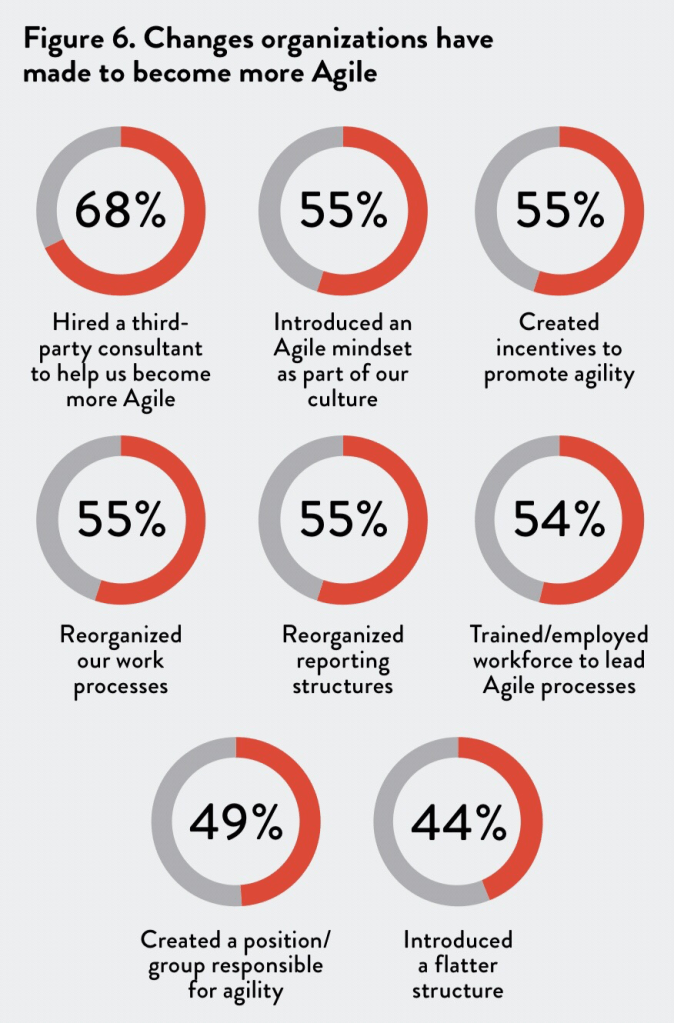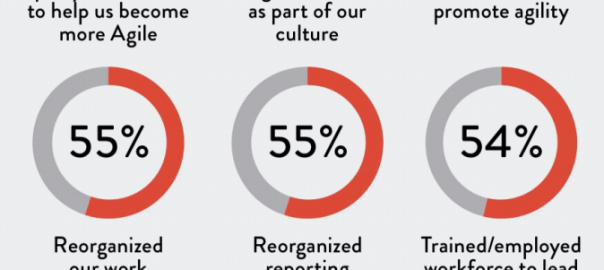
The Scrum Alliance recently partnered with Forbes Insights to conduct a study of Agile Leaders and Agile Transformation success. The study was published as “The Elusive Agile Enterprise” in November, 2018. Though there were few major surprises in the results, there were some interesting tidbits.
The study was conducted in 2018 and included surveys of over 1,000 executives and agile leaders from small and large global corporations (all were over $ 100M in revenue). You can download your copy of the report with free registration at Elusive Agile Enterprise.
I was a little surprised to see the statistics on transformation success. Two out of three respondents felt that their agile transformations had been very or extremely successful. This is much higher than the anecdotal results that I cited in my related article, Most Agile Transformations Will Fail.
The First Step to Business Agility is… Get Executive Buy-in and Agile Mindset
One of the things that you will not find surprising is that a key finding is the importance of C-suite-level buy-in for any transformation to be successful. It seems that to have an agile enterprise, your executives need to be agile leaders. Duh!
Lack of Executive Support has been mentioned in all the recent VersionOne Annual State of Agile Reports. The most recent VersionOne report had “Inadequate management support and sponsorship” as the #3 barrier for agile adoption, with 42% of respondents.
But the Forbes Study puts a fine point on C-suite buy-in and adoption. A full 83% of the respondents stated that the Agile Mindset/Flexibility is the most important characteristic for executives. They rated this higher than the ability to manage and attract talent, and being a great communicator. Stated differently, agile thinking is more important than who you hire or how you communicate. Wow.
83% of the respondents cited the Agile Mindset/Flexibility was the most important characteristic for executives
Survey respondents felt it important the CEO lead the way with Agility, with 87% responding that the CEOs as the biggest champions of organizational agility. And a full 70% of leaders who responded blamed the lack of engagement by senior executives and employees as the reason for an unsuccessful transformation. (Additional obstacles to agility included: competing priorities (67%), a lack of Agile champions (57%) and not knowing how to become Agile (56%).)
So, the most important thing is for the executive suite to have an agile mindset. Easily done right? Well, unfortunately it is not that easy. People tend to write it off as a process change, or fail to appreciate that they don’t know what they don’t know about agile. I’ve written previously about the fact that people tend to overestimate their understanding of agile.
In addition to the importance of the executive team being on board with agile and having an Agile mindset, the report included lays out these additional steps to achieving Agility:
• Step 2: Hire and develop the right mix of talent
• Step 3: Foster an Agile-friendly culture and organizational structure
Let’s look at each of these in detail.
Step 2: Agile Leaders Should Get the Right Mix of Talent
The second recommended step was to get the right mix of talent in the organization. One thing that I disagreed with in the study results was putting the responsibility for the lack of agility on the workforce. As an old guy myself, I felt a little defensive that they singled out the more senior employees as the ones resistant to change.
“According to our survey findings, the biggest detractors of organizational agility are longtime employees (29%)—workers who are comfortable in their current roles and staunchly resistant to change.”
It seems that the people being blamed for not being agile are the ones who have for a long time been told what to do, within a system that rewarded compliance and punished those who took risks. Now, those long serving employees are being scapegoated as the reason the organization is not agile. That feels off to me.
The report doesn’t entirely absolve leaders and managers though.
“Even executives, frightened by the rising need for rapid decision making and greater risk-taking, can cling to traditional management approaches against an overwhelming track record of poor results.”
Step 3: Foster an Agile-Friendly Culture and Organization Structure
This third step to agility is one that I completely agree with. In fact, establishing the culture and organization structure may be the MOST IMPORTANT step. You may recall Craig Larman’s 5th law of organizational behavior, “Culture Follows Structure”.
Most agile leaders will take steps to flatten the organization to create fewer levels. This can increase autonomy and speed decision making by putting decisions in the hands of those who are closest to the problem.
I think it is also important to organize to reduce silos and align to customer delivery. Frequently the waterfall delivery approach is made necessary by organizations that have functional silos and work has to be handed off from one group to another. This creates knowledge loss, delays, and lack of ownership.
I did take exception to another statement in the report “How do leaders drive organizational agility?”. I am not sure that “driving” agility is a great idea. I would prefer to see agile leaders who are casting vision, inviting people to participate and creating an environment for people to participate, or self-select out.
Other Changes Agile Leaders Have Made
The study also included the chart below which shows the various steps that organizations and agile leaders have taken to become more agile. Some of these I completely agree with, like training on agility or reorganizing and flattening the organization. Here are a couple that I don’t agree with:
- Creating Incentives to Promote Agility – This could cause a problem in that once you begin incenting people, you will need to continue. Those who think that creating incentives will motivate people to adopt agile should review Frederick Herzberg’s timeless HBR article, One More Time How Do You Motivate Employees. Instead, organizations should consider intrinsic rewards. People are motivated by autonomy and new challenges. Why not give them both of these and allow the learning and growth that is necessary for agility to be the reward in itself?
- Creating a Position or Group to be Responsible for Agile – This may not be a bad thing, depending on how it is initiated and structured. I do like the idea of an overall agile champions team made up of agile leaders in the organization. However, I would be very concerned if agility was positioned as someone else’s job or if there was a central group responsible for setting agile standards and best practices.

The study also notes that “Employees must learn new behaviors, such as thinking independently, taking risks and collaborating”. Again, think that puts a lot on the employee. Or perhaps it is a chicken and egg thing. Which comes first, employees taking risks, or managers and leaders creating the environment where risk taking is rewarded and not punished?
The study does give some examples of how companies have created that safe to fail environment. Similar to the blameless post-mortem, GE Healthcare host quarterly exercises that focus on failure, and learning. The exercise is intended to legitimize failure, growth, and learning.
We have to look at this through the lens of systems thinking. The actors in the system behave rationally based on the way the system is set up.
Next Steps for Agile Leaders
If you are planning an Agile Transformation or have one underway, it may be helpful to think about these questions:
- What is the level of understanding and buy-in for Agile at the executive level? Do they think of it as just ‘do more with less’ or ‘faster results’, or do they really understand the idea of creating business agility?
- How big is the gap between how our ‘system’ operates today and what it needs to be? Do we have a heavily command and control culture? Do we have many long time employees who are accustomed to being told what to do or being punished for mistakes?
- Is our organization structured for business agility? Do you have organizational silos that compete rather than collaborate? What would need to change to align your organization to deliver to your customers quickly and with high quality?
If you enjoyed this article, you might also find this interview with Technology Leader David Sohmer helpful – How Technology Managers Can Succeed as Agile Leaders.
This article originally appeared on Vitality Chicago’s Blog and has been republished with permission.
Business & Finance Articles on Business 2 Community
(55)





